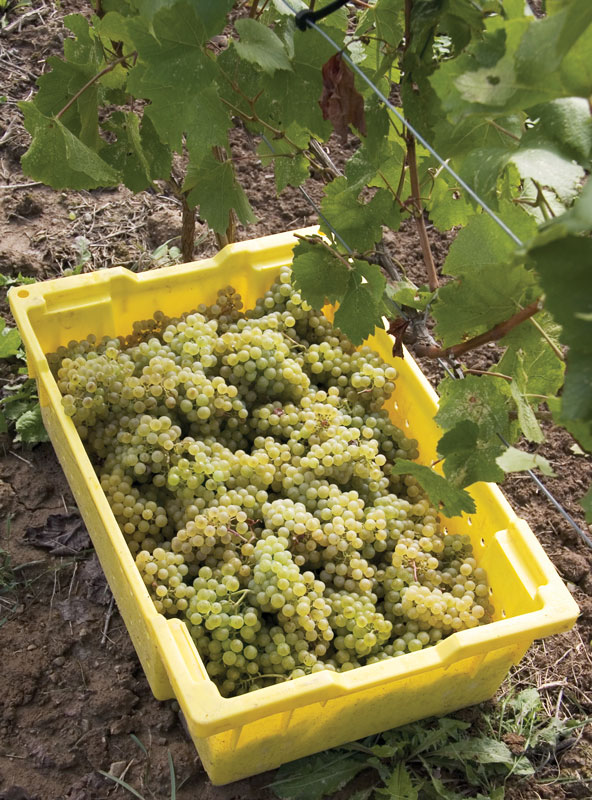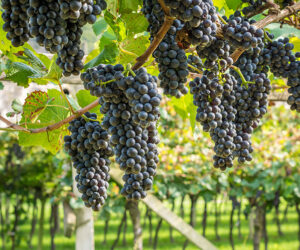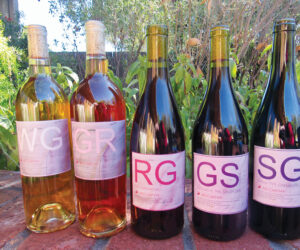Never judge a book by its cover. We probably all heard this cliché from our parents at some point of our young lives. In the case of the grape we will be discussing here, the cover is referring to the varietal’s name. In Europe, grapes are identified by both region and varietal name. While too numerous to list all the possibilities, if we said Bordeaux, we have got a choice of white or red. Whites narrow to two varieties, Sauvignon Blanc and Sémillon. Red wines narrow your choices to five, Cabernet Sauvignon and Merlot being the two top choices. Provence opens up some more choices, but still a familiar list, including Marsanne, Roussanne, and Viognier for white wines, and Syrah, Grenache Noir, and Mourvèdre as just some of the reds.

Elsewhere in the world, it is often the grape variety that we identify with. If I said “Napa,” you might assume it is Cabernet Sauvignon, but that would not necessarily be the case. They do grow Syrah in California’s Napa County, but they do not grow Syrah in Bordeaux. In the Hunter Valley of Australia, you might assume Sémillon, but alas, while Hunter Valley grows prized Sémillon, other varieties are grown there as well. One variety that has been difficult for me to flesh out was only better understood after a trip to the Loire Valley in France. It was not Chenin Blanc, but it was white. And I think the biggest source of confusion was its name . . . Melon de Bourgogne, or just plain Melon here in the United States, but also known in some circles as Muscadet.
So why was there confusion in my mind, and for that matter, why did it take a trip to France to better understand this? Melon de Bourgogne is a white grape of the lower Loire Valley, near the Atlantic coast in the Pays de Loire region, pretty far from Burgundy. And the Muscadet (pronounced Mus-ka-day) is an alleged characteristic of the wine, as having a Muscat character or muskiness, referred to in French as vin qui a un goût musqué. Many would argue against this characteristic in Melon and, in fact, there is no Muscat grape in its DNA lineage. There is another theory for the Muscadet origins and it derives from the grape’s history for brandy production. It surmises that the name could refer to the spice, noix de muscade (nutmeg), which was added to the wine prior to the distillation process.
Despite its name, the varietal was literally kicked out of Burgundy and banned from the province in the 16th century.
The origins of the name Melon are still speculative as well. One idea is that it is derived from the Latin word misculare, which means “to mix.” Another theory is that the round shape of the leaves is similar to that of a melon plant. Writings of the region from the 17th century also refer to it simply as Bourgogne, so Melon was definitely added later on. Despite its name, the varietal was literally kicked out of Burgundy and banned from the province in the 16th century. The region and its leadership favored the more popular Chardonnay and Aligoté white grapes.
Nonetheless, according to Jancis Robinson Melon is the fourth most planted white grape varietal in France, just ahead of Sémillon, but way far behind Sauvignon Blanc. The plantings are almost exclusively at the western end of the Loire River Valley, where there are three sub-appellations of the overall Muscadet appellation. Most is grown in the Muscadet-Sèvre et Maine, producing over 80% of all Muscadets and the other Muscadet-Coteaux de la Loire and Muscadet-Côtes de Grandlieu.
Viticulturally, the variety is mid-season ripening and best to be pruned “long” as its basal buds produce very little fruit. We understand this better as cane pruning. It is somewhat frost resistant and in its maritime climate it is susceptible to Botrytis bunch rot, but not powdery mildew. It has small, golden-yellow berries.
The wines from this grape are simple. Two of my favorite features of Melon are its flavor profile and low alcohol. While there is quite a spectrum of styles, alcohols are typically less than 12% and the flavors are typically citrus based and then what some describe as minerality. The term minerality has been long debated, and when I was a student at UC-Davis
I used this term because I did not know a better way to describe a very simple wine. The person who I was describing this to was in fact Dr. Ann Noble, the professor of sensory science and inventor of the wine aroma wheel. To which Dr. Noble asked — “And what do you mean by that term?” I really didn’t know how to answer her, other than it was something I read in some other writer’s review. Many years later, a formal sensory project was conducted and the general consensus of the term referred to a perceived saltiness. It is not just for Melon, this term is used for other wines as well, like Chablis and Chenin Blancs from cooler regions.
The acidities of the Muscadet wines are high, and the pHs are low. Sometimes approaching pH levels of 3.1 or below, which historically made it difficult for them to undergo the secondary malolactic fermentation or conversion. Winemakers throughout the region added some depth or mouthfeel to the wines by aging them sur lie, which translates to “on the lees.” Some even regularly stirred the lees, which can add more mouthfeel or body to the wine. Stirring also provides nutrients from the autolyzing yeast cells to help encourage the malolactic fermentation to completion. Regardless of the variety that I am working with, if I find I have a wine that is not moving through the secondary fermentation, I will stir the lees and in most cases it will be successful. I am not a big proponent of malolactic conversion in white wines, but that is a preference on my part, in that I am dealing with California fruit with mostly low acidities and I am trying to preserve every bit of acidity I can get. Winemakers working with white grapes high in acidity, especially Melon, should take advantage of this natural de-acidification process.
Outside of France, there is little in the way of Melon plantings, mostly along the West Coast in California, Oregon, and Washington. Famed winemaker Georges de Latour, who established Beaulieu Vineyard (BV), brought to California what he thought was Pinot Blanc and for years these vines were propagated throughout California and up the coast. Some refer to this as a mini scandal, but the reality was that they were just mislabeled, and called what they were thought to be. As ampelographic and DNA science improved in the 1980s, it was learned that these vines were actually Melon de Bourgogne. This started a very small but enthusiastic following of Melon, with De Ponte Cellars in the Willamette Valley leading the charge. So little is grown, that it does not show up in any vineyard acreage reports put out by the United States Department of Agriculture, but the California Department of Food and Agriculture reports a mere 55 tons crushed in 2019. The regions producing Melon, not surprisingly are Sonoma, Monterey, and San Luis Obispo counties, all of them with a maritime influence in close proximity to the Pacific Ocean.
I find the Muscadet wines are paired perfectly with seafood and shellfish. Even though the grape is banned in Burgundy one of our favorite restaurants in Dijon, now closed, specialized in mussels and was stocked with Muscadet wines. Ironically, you cannot grow the grape but you can have the wine!
Alas, I am not surprised it took as many years for me to understand Melon, Melon de Bourgogne (not really in Bourgogne), Muscadet (not really Muscat), were all just synonyms for the same thing. I long for the day when the pandemic will end and we can open up the borders and start traveling again. I think one of my first trips will be back to Burgundy and then a lazy float down the Loire River passing the famed Châteaus of the upper Loire, the famed Chenin Blanc and Cabernet Franc vineyards further downstream, and then west to Nantes, where we will seek out the Muscadet and briny mussels we love. Enjoy!
Melon De Bourgogne recipe (Yield 5 gal/19 L)
Ingredients
100 lbs. (45 kg) Melon de Bourgogne fruit
Distilled water
10% Potassium metabisulfite (KMBS) solution. (Weigh 10 g of KMBS, dissolve into about 75 mL of distilled water. When completely dissolved, make up to 100 mL total with distilled water.)
5 g Zymaflor VL3 or Anchor VIN13 yeast (Lalvin QA23 can also be used as a substitute)
5 g Fermaid K (or equivalent yeast nutrient)
5 g Diammonium phosphate (DAP)
Rice hulls
Dry ice (~3 lbs./1.36 kg)
Other equipment or needs specific to this recipe
Destemmer-crusher
Basket press
Food-grade plastic tub ~18 gal. (68 L)
5-gallon (19-L) carboy
6-gallon (23-L) carboy
6-gallon (23-L) plastic bucket
Airlock/stopper
Racking hoses
Equipment cleaning and sanitizing agents (Bio-Clean, Bio-San)
Inert gas (nitrogen, argon, or carbon dioxide will do)
Refrigerator (~45 °F/7 °C) to cold settle the juice. (Remove the shelves so that the bucket will fit.)
Ability to maintain a fermentation temperature of 55 °F (13 °C)
Thermometer capable of measuring between 40–110 °F (4–43 °C) in one degree increments
Pipettes with the ability to add in increments of 1 mL
Step by step
- Crush and press the grapes to the large tub. Place some chunked dry ice into the tub. You want to see visible gassing, bubbling from the must.
- Measure the volume of the must and mix in the rice hulls. The rice hulls should be about 30% of the total volume. Move the must to your press. Ensure a minimal delay between crushing and pressing. Extended skin contact is not desired.
- Move the must/rice hull slurry directly to the press. Press to the 6-gallon (23-L) bucket. Again place some dry ice chunks into the bucket. The rice hulls aid in pressing by creating juice channels. Your juice yields will increase significantly with their use.
- While pressing the juice to a 6-gallon (23-L) bucket, add 16 mL of 10% KMBS solution (This addition is the equivalent of 40 mg/L SO2). Move the juice to the refrigerator.
- Let the juice settle at least overnight, two days is ideal. Layer the headspace with inert gas and cover.
- When sufficiently settled, rack the juice off of the solids into the 6-gallon (23-L) carboy.
- Prepare yeast. Heat about 50 mL distilled water to 104 °F (42 °C). Sprinkle the yeast on the surface of the water and gently mix so that no clumps exist. Let sit for 15 minutes undisturbed. Measure the temperature of the yeast suspension. Measure the temperature of the juice. You do not want to add the yeast to your cool juice if the difference in temperature of the yeast and the must exceeds 15 °F (8 °C). To avoid temperature shock, acclimate your yeast by taking about 10 mL of the juice and adding it to the yeast suspension. Wait 15 minutes and measure the temperature again. Do this until you are within
the specified temperature range. Do not let the yeast sit in the original water suspension for longer than 20 minutes. When the yeast is ready, add it to the fermenter. - Add Fermaid K or equivalent yeast nutrient.
- Initiate the fermentation at room temperature, ~65–68 °F (18–20 °C) and once fermentation is noticed, (~24 hours) move to a location where the temperature can be maintained at 55 °F (13 °C).
- Two days after fermentation starts, dissolve the DAP in as little distilled water required to completely go into solution (usually ~20 mL). Add directly to the carboy.
- Normally you would monitor the progress of the fermentation by measuring Brix. One of the biggest problems with making white wine at home is maintaining a clean fermentation. Entering the carboy to measure the sugar is a prime way to infect the fermentation with undesirable microbes. So at this point, the presence of noticeable fermentation is good enough. If your airlock becomes dirty by foaming over, remove it, clean it, and replace as quickly and cleanly as possible. Leave alone until bubbles in the airlock are about one bubble per minute. Usually about two to three weeks.
- Measure the Brix. The wine is considered dry, or nearly dry when the Brix reaches -1.5 °Brix or less. Taste the wine too! This is probably the best indicator that the wine is dry. If it tastes sweet, it is sweet.
- When the fermentation is complete, add 3 mL of fresh KMBS (10%) solution per gallon (3.8 L) of wine.
- Transfer the wine off of the gross lees to the 5-gallon (19-L) carboy and lower the temperature to 38–40 °F (3–4 °C). Make sure there is no headspace. Fill the carboy to the top! If you have leftover wine, you might as well have this with dinner.
- After two weeks, test for pH and SO2 adjusting as necessary to attain 0.8 ppm molecular SO2. (There is a simple SO2 calculator at www.winemakermag.com/guide/sulfite). Check the SO2 in another two weeks, prior to the next racking and adjust while racking. HINT: Rack to another sanitized 5-gallon (19-L) carboy, or your bucket. In the case of the latter, clean the original carboy and transfer the wine back to it. This is done at about 4–6 weeks after the first SO2 addition. Once the free SO2 is adjusted, maintain at the target level by monitoring every 3–4 weeks.
- Age the wine on the light lees, stirring about every two weeks for about three months. This is referred to as sur lie aging.
- Let the lees completely settle out. Rack the wine to a clean and sanitized carboy to prepare for bottling.
- Consult winemakermag.com for tips on fining and filtration.
- Be sure to maintain sanitary conditions while bottling. Once bottled, you’ll need to periodically check your work by opening a bottle to enjoy with good friends.







